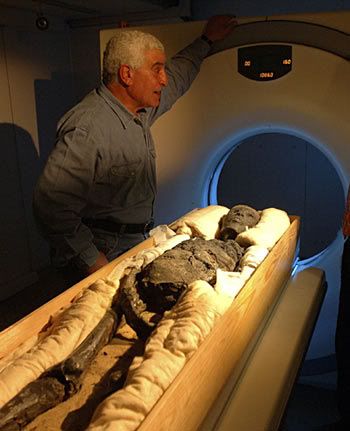
King Tut wasn't murdered by a blow to the head, nor was his chest crushed in an accident. But after ruling out those long-time theories, the most revealing tests ever performed on the boy pharaoh's mummy didn't solve the mystery of how he died.
The results of the high-tech CT scan released yesterday raised one new possibility: They suggested that just days before his death, Tutankhamen might have badly broken his left thigh, puncturing the skin -- an injury that could have caused a dangerous infection.
But not everyone on the Egyptian-led team that pored over 1,700 CT images of Tut's body taken two months ago agreed with that theory. Some said the fracture could have occurred from mishandling when the mummy was discovered in 1922 in Luxor's Valley of the Kings.
Zahi Hawass, head of Egypt's Supreme Council of Antiquities, said the study allowed him to rule out violent death, but left him with no idea how Tut died. He said further tests will try to determine whether Tut died from natural causes, or perhaps was poisoned, but he stressed that it is unlikely they will find an answer.
Still, the CT results provided the most revealing insight yet into the life of ancient Egypt's most famous king, who ruled 3,300 years ago.
Tutankhamen was a well-fed, healthy, yet slightly built 19-year-old, standing 5 feet 6 inches tall at the time of his death, the test suggests. It was the first time his age has been established.
He had the typical overbite characteristic of other kings from his family and a slight cleft palate, which did not cause a cleft lip or other facial deformities. He also had large incisor teeth and his lower teeth were slightly misaligned.
While much interest has surrounded Tut's life, most attention has focused on how he died. X-rays taken in 1968 by Liverpool University anatomists found bone fragments inside Tut's skull, suggesting he might have been slain by being hit on the head.
But Mr. Hawass said the CT scan, the first ever performed on an ancient Egyptian king, ruled that out.
"The team found no evidence for a blow to the back of the head, and no other indication of foul play," he said.
He suggested that the fragments came from royal funerary workers who drilled a hole into the skull to let embalmers pour resins and other fluids in to prepare the body for mummification.
Some on the CT-scan team, which included two Italian experts and one from Switzerland, speculated that damage to the skull and upper neck might have been caused by the archaeological team led by Briton Howard Carter when they removed the pharaoh's famous golden mask after discovering his tomb.
Mr. Hawass said the team discounted a theory that the absence of Tut's sternum and most of his front ribs indicated a traumatic death.
"They also found it extremely unlikely that he suffered an accident in which he crushed his chest," he said, adding that such an injury would have caused damage elsewhere in the body, such as the spine, and the team saw none.
Mr. Hawass said he had no firm idea of how Tut died. But he offered two theories.
"He may have died from natural causes or was poisoned. We are going to look at his viscera to see if his organs show any signs, but it is virtually impossible to prove how he died," he said, giving no details on more tests or when they would be performed.
Mr. Hawass said Tut's death, around 1323 B.C., was surprising considering he was only 19, appeared to be healthy and suffered no infectious diseases or major childhood malnutrition.
"The mystery of his death will continue, but the case over whether he was [violently] murdered is closed," he said.
The CT scan, during which Tut's leather-like mummy was briefly removed from its tomb and placed into the scanner, did not address questions about Tut's precise royal lineage. It is unclear whether he was the son or a half brother of Akhenaten, the "heretic" pharaoh who introduced a revolutionary form of monotheism to ancient Egypt and was the son of Amenhotep III.
Mr. Hawass reiterated his refusal to allow DNA testing on Tut's remains, saying the science has a 40-per-cent chance for error when used on mummies.
"I believe these results will close the case of Tutankhamen, and the king will not need to be examined again," he said. "We cannot go again and open this mummy at all -- King Tut will rest forever."
http://www.theglobeandmail.com
No comments:
Post a Comment